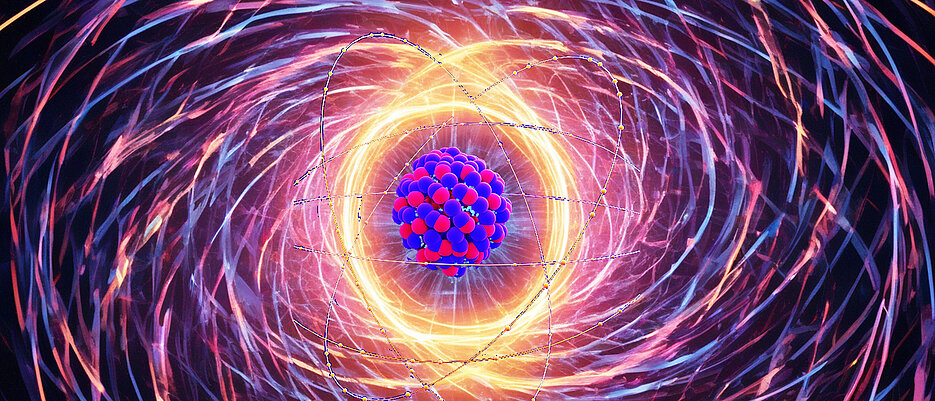A new and more precise way of measuring time is the aim of an international research project in which Würzburg physicist Adriana Pálffy-Buß is involved. The results could also help in the search for dark matter.

The global navigation system GPS, digital data traffic in the telephone network, measuring the earth from satellites: All these technologies would not work without precise timekeepers. Here, a few billionths of a second are crucial for the results to be correct. Science – especially physics – is also dependent on extremely precise clocks if it wants to find out, for example, what dark matter is made of or whether natural constants are actually constant.
A fundamentally new basis for such a high-precision timepiece is the focus of an international research project that has now been approved. At the end of 2023, the Austrian Science Fund FWF has set up a so-called “Special Research Area” for this purpose, comparable to a Collaborative Research Centre of the German Research Foundation (DFG).
Over the next four years, teams from the University of Vienna and the Vienna University of Technology, the Institute of Science and Technology Austria and Julius-Maximilians-Universität Würzburg (JMU) will be working together on the project, which is funded with 3.1 million euros. Adriana Pálffy-Buß is involved in the project from Würzburg. The expert in X-ray quantum optics took over the professorship for Theoretical Quantum Information and Quantum Optics at JMU at the beginning of 2022. With her group, she also conducts research in the Würzburg-Dresden Cluster of Excellence ct.qmat – Complexity and Topology in Quantum Materials.
Increasing the Measurement Accuracy of Physical Methods
“Researchers led by Oliver Heckl from the University of Vienna want to increase the measurement accuracy of physical methods in the special research area ‘Coherent Metrology beyond Electric Dipole Transitions’. An innovative method that uses light with orbital angular momentum will be used,” according to the FWF press release. What does this mean?
“The most precise timekeepers today are atomic clocks, which measure time based on the frequency of the transitions that electrons make between the different energy levels of an atom. In our project, we want to use a newly developed narrow-band laser to make an atomic nucleus jump between energy levels and emit photons, i.e. particles of light, in the process. Such a nuclear clock could increase measurement accuracy by a factor of about 3,” explains Adriana Pálffy-Buß.
Research on an Isotope of the Element Thorium
The research team is focusing on an isotope of the element thorium. The thorium nucleus in question has 229 nuclear building blocks – protons and neutrons – and can reach an excited state that is only around eight electron volts more energetic than its lowest energy state, the so-called ground state. “This difference is so tiny by the standards of nuclear physics that the two states were barely distinguishable when they were first observed,” says Pálffy-Buß. At the same time, it is this difference that could make a “nuclear time measurement” possible. Experimental proof of this jump from the excited to the ground state of a thorium nucleus with the emission of a photon was achieved in 2023.
Shoot thorium atoms with a laser and capture the photons you are looking for: Unfortunately, the “nuclear clock” doesn’t work that easily. One of the reasons for this: “You need around eight electron volts to excite the nucleus. However, six electron volts are enough to remove the outermost electron from its orbit. In this case, the excited nucleus prefers to transfer its surplus energy to the electron instead of emitting a photon. However, this must be avoided,” explains the physicist. The solution to this problem could be to incorporate thorium atoms into special transparent crystals. “The corresponding experiments showed that thorium takes its place in the crystal lattice in an ionic state – in other words, it gives up its outer electron,” explains Pálffy-Buß. The crystal can also host many thorium nuclei at once, which makes it easier to detect the photon being sought.
Rotating Corkscrews as Solution
Another problem: to date, there is no laser with the necessary precision to trigger the desired effect. The Austrian-German research team is therefore relying on the aforementioned “innovative method that uses light with orbital angular momentum”. This is also referred to as twisted light or vortex beams.
In very simplified terms, laser pulses do not hit the thorium atoms like an “energy wall” in this method. Instead, they resemble a kind of rotating corkscrew and are therefore more likely to put the atomic nuclei into the desired excited state.
Theory Calculations for the Ideal Scenario
As an expert in theoretical physics, Adriana Pálffy-Buß will primarily support the research project with her calculations. “I design and simulate what would happen in various experimental set-ups and make proposals what would work best,” summarizes the physicist her contribution. Among numerous approaches, she tries to identify the most promising scenario. For that, she receives around 375,000 euros from the special research area’s funding pot – enough to finance two doctoral positions.
For physicists, this research project is super exciting, says Pálffy-Buß. “A nuclear clock would make it possible to investigate concepts that are normally taken for granted, such as the question of whether fundamental physical constants are really constant.” It could also help to answer the question of what dark matter is made of. “Due to the fundamental interactions that play a role in nuclear transitions, the nuclear clock is in a unique position to answer such questions,” concludes the physicist.








